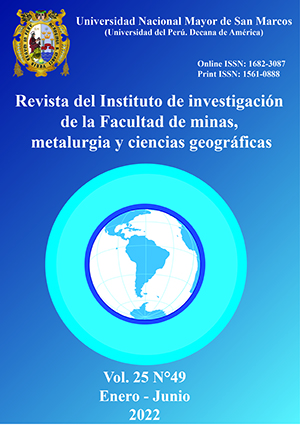Aquatic macroinvertebrates and water quality in the Ventanilla Wetlands Regional Conservation Area, Callao
DOI:
https://doi.org/10.15381/iigeo.v25i49.23013Keywords:
water quality, conductivity, wetland, biotic indices, aquatic macroinvertebratesAbstract
Ten bodies of water were evaluated in the Ventanilla Wetlands located in the Callao region, in Peru, in the months of March and August 2018. The objective was to study the community of aquatic macroinvertebrates and their application to determine the quality of Water. For this, physicochemical parameters were recorded in situ and a 500 µm D-net was used for the biological collection. The values of the physicochemical parameters were in accordance with what is recommended in the national regulations, except for electrical conductivity, which exceeded the limit in water bodies near the sea. The aquatic macroinvertebrates were represented by 17 taxa, including gastropods and arthropods, of which the former were the most abundant (85.5% in March with 2555 organisms/m2 and 74.2% in August with 4422 organisms/m2), and the latter, the most diverse. The Wisconsin Wetland Macroinvertebrate Biotic Index (WWMBI) categorized water bodies as “very poor” and “poor” quality, probably due to the presence of organic matter, gastropod dominance, or heavy metal contamination. Finally, it was reported that electrical conductivity influenced the distribution of aquatic macroinvertebrates. Likewise, it is suggested to develop biotic indices for coastal wetlands in our country.
Downloads
Published
Issue
Section
License
Copyright (c) 2022 Harry Canales Cuadros, Carlos Cabrera Carranza, Jerry Arana Maestre

This work is licensed under a Creative Commons Attribution 4.0 International License.
AUTHORS RETAIN THEIR RIGHTS:
a. Authors retain their trade mark rights and patent, and also on any process or procedure described in the article.
b. Authors retain their right to share, copy, distribute, perform and publicly communicate their article (eg, to place their article in an institutional repository or publish it in a book), with an acknowledgment of its initial publication in the Rev. Inst. investig. Fac. minas metal cienc. geogr.
c. Authors retain theirs right to make a subsequent publication of their work, to use the article or any part thereof (eg a compilation of his papers, lecture notes, thesis, or a book), always indicating the source of publication (the originator of the work, journal, volume, number and date).






